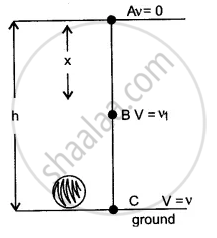Advertisements
Advertisements
प्रश्न
Show that in case of a body falling freely under gravity, total mechanical energy remains conserved (neglect air resistance).
उत्तर
Let a body of mass m fall freely under gravity from height h above the ground.
Let A, B, and C be the positions of the body.
Let x be the distance fallen from A to B.

At position A :
KE = 0 .......(body is at rest)
and PE = mgh
∴ Total energy = 0 + mgh = mgh ..........(i)
At position B :
Let v1 be velocity of body, then u = 0, S = x.
From equation v2 = u2 + 2aS
v12 = 0 + 2gx = 2gx
Since KE =`1/2` mv2 = `1/2` m × 2gx = mgx
and PE = mg (h − x)
= mgh − mgx
∴ Total energy = mgx + mgh − mgx = mgh ..............(ii)
At position C :
Let velocity of body be v, then u = 0, S = h.
From equation v2 = u2 + 2gS
v2 = 0 + 2gh = 2gh
Since KE = `1/2` mv2 = `1/2` m × 2gh = mgh
and PE = 0
∴ Total energy = mgh + 0 = mgh ............(iii)
From (i), (ii) and (iii) it is clear that sum of mechanical energy remains same at any point in the path of free fall of a body.
APPEARS IN
संबंधित प्रश्न
State the energy change in the following device while in use:
A glowing electric bulb.
What name is given to the heat energy obtained from hot rocks inside the earth?
Write an expression for the potential energy of a body of mass m placed at a height h above the earth's surface. State the assumptions made, if any.
What do you understand by the kinetic energy of a body?
State the work energy theorem.
Give one disadvantage of using a solar cell.
MULTIPLE CHOICE TYPE:
The ultimate source of energy is:
(a) wood
(b) wind
(c) water
(d) sun
Write five forms of energy.
What do you understand by the potential energy of the body?
What is nuclear energy? Explain the principle of producing electricity using nuclear energy is a nuclear reactor.
